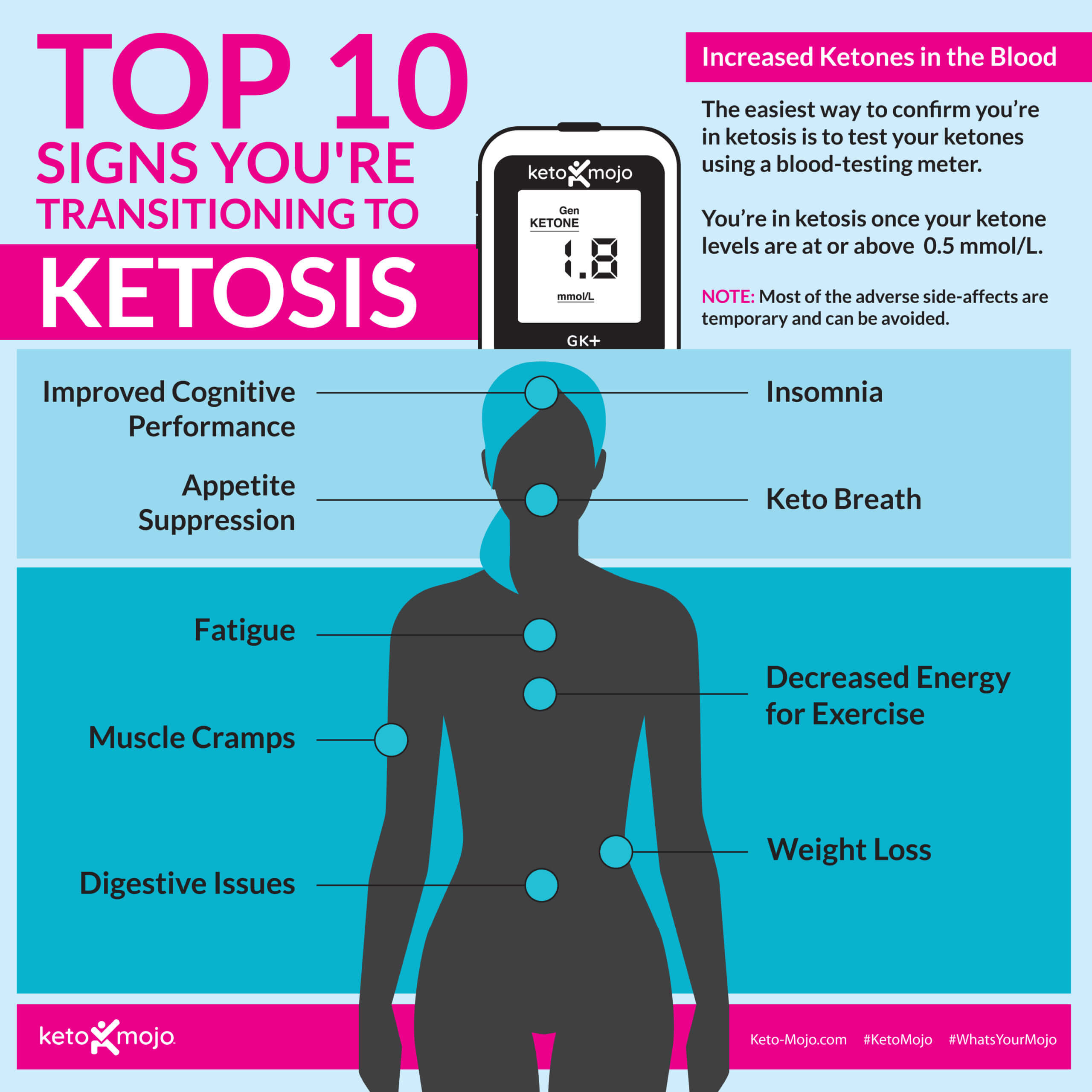When you start a keto lifestyle, you embark on a very low-carbohydrate, moderate protein, high-fat diet. The goal is to get your body into and stay in nutritional ketosis, or to burn fat for your source of energy (fuel) instead of carbohydrates (carbs). Fasting, intermittent fasting, or consumption of exogenous ketones (MCT oil or medium-chain triglycerides coconut oil) can get you into ketosis faster. But to reach ketosis through a keto meal plan featuring a high-fat, low-carbohydrate diet can take up to a week, even if you eat just the right amount of daily macros, including plenty of healthy fats (including olive oil and dairy products) and moderate protein intake.
So how will you know when you’ve gotten into a fat-burning state and can begin to reap the health benefits of burning ketones for fuel? Your body will offer clear signs of ketosis along the way. Some are welcomed (Hello, weight loss, lower blood sugar—i.e. blood glucose––levels, and reduced bloating!), while others are more challenging. All are signs that your body is making the transition from relying on glucose (carbs/sugar) for energy to using fat and ketones for fuel.
If you want to know whether you’re moving into a state of ketosis, look for the following signs. Whether you have some or all of them, they’re indications that you’re on your way to raising your levels of ketones.
How Do You Know if You’re in Ketosis?

The Top Ten Signs You’re Moving Into Ketosis
#1. Increased Ketones in the Blood
The easiest and most accurate way to confirm you’re in ketosis is to test your ketones using a blood ketone meter. You’re in ketosis once your blood ketone levels are at or above 0.5 mmol/L. Once your body converts to using ketones for fuel, your ketone levels may go down some from the initial rise. This doesn’t mean you aren’t in ketosis. As long as your ketones are registering 0.5 mmol/L or higher, your body is still being programmed to burn fat and stay in ketosis!
By using the Keto-Mojo blood glucose and ketone meter and downloading the MyMojoHealth app, you can easily track and monitor your ketones and discover meaningful insights to empower your decisions.
#2. Weight Loss
Many dieting people follow a ketogenic diet for the weight-loss benefits, which can be significant, especially if you stick with the lifestyle for a good amount of time. But when you first start on keto, you may experience rapid weight loss. This is because ketosis has a diuretic effect on your body, resulting in a quick loss of water weight (for this reason, take steps to stay hydrated). As your body becomes more used to keto and converts fat to ketones for fuel, you will experience more body fat loss over time.
#3. Fatigue
Fatigue is a common and short-term side effect when transitioning to a lifestyle in ketosis. It’s typically due to dehydration, which is part of the Keto Flu. When you cut way back on your carbohydrate intake, your body produces less insulin and uses up its glycogen stores. When this happens, your body excretes more water with the glycogen (which is why you tend to lose water weight quickly on keto). The quick loss of water weight can cause dehydration, making you feel more fatigued. This is another reason you want to stay hydrated. It’s also reason to add a pinch of Himalayan salt to your water; it’ll help balance your electrolytes, which are likely to become depleted with the quick water loss.
#4. Improved Cognitive Performance
You might experience a bit of brain fog during your initiation to keto, but after a couple of weeks, expect to have better all-around cognition performance. Why? Because the brain loves ketones. Studies show that ketones improve all areas of cognitive function, including mental clarity, focus, and concentration. Additionally, you may also experience improved mood and decreased anxiety-related symptoms.
#5. Decreased Energy for Exercise
When you first start keto, fatigue can extend to your ability to exercise with the same energy levels you’re used to. In fact, you may feel you just don’t have it in you at all. That’s okay. Decreased performance is also common and short-term when you begin a keto diet. When your body is used to burning glucose to power your workouts and that glucose is depleted due to a lack of carb consumption, your body is trying to figure out where to find energy. Once your body adjusts to reaching for ketones as its fuel source, you’ll not only be back to your regular performance levels, you may also find you’ve got even more endurance. Give yourself a couple of weeks to adjust to keto and the symptom will dissipate.
#6. Appetite Suppression
There are two specific hormones that influence our hunger and appetite. One hormone, grehlin, is known as the appetite hormone. The other is cholecystokinin (CCK), a hormone that makes you feel full. With increased ketone levels, there is a reduction in these two hunger-related hormones, so you end up feeling less hungry and more satiated between meals. You’ll also notice you can effortlessly go for longer periods of time (i.e. be in a fasted state) without eating or feeling hungry and will have fewer cravings for processed/sugary foods.
#7. Keto Breath or Bad Breath
If you’re getting a fruity, acetone (like nail polish remover), or metallic smell to your breath, you’re getting what’s known as “keto breath.” When your body converts to burning fat for energy instead of glucose, the byproduct is ketones, one of which is called acetoacetate. When you first start producing ketones, your body will create more of them than it will initially use and you may smell it on your breath. Once your body has no more glucose stores to draw from for energy and starts getting more efficient at using ketones for energy, keto breath typically resolves.
#8. Digestive Issues
When you first start on keto and your body is not used to a high-fat diet, you may initially notice some digestive issues such as diarrhea or constipation. During the transitional period, it may be helpful to take digestive enzymes designed to assist with fat digestion. This can help with diarrhea. For constipation, be sure you are eating a clean keto diet with adequate vegetables for fiber. Like the other initial symptoms of transitioning to a keto diet, digestion should improve once your body adjusts.
#9. Insomnia
Trouble staying asleep is yet another sign you’re adjusting to the changes that come with ketosis. Studies show you may initially have shorter stages of REM or “dream” sleep on keto. But things should resolve within a couple of weeks.
#10. Muscle Cramps
When you cut down to very low carb intake, your body produces less insulin (insulin processes the glucose in carbs). With less insulin, your kidneys release more sodium, which can throw your other essential electrolytes out of balance and lead to temporary muscle cramping. As with fatigue, adding a pinch of Himalayan salt to your water can help balance your electrolytes and give you some relief.
The Final Word
Don’t expect to get into ketosis fast; it takes time for your body to adjust to your new metabolic state and a reliance on fat intake as its primary energy source rather than excessive grams of carbs. All of the above signs are indications that you’re in ketosis and on your way to the next step and the ultimate goal of a ketogenic lifestyle: fat adaptation. Being “fat-adapted,” or being fully transitioned to relying on fat for energy can take many weeks to several months of dietary mindfulness, including watching your net carbs or total carbs depending on your preference. But once you’re there, you’ll reap the benefits of continued fat loss (great for people battling obesity), sustained energy and focus, less hunger and irritability between meals, and better overall wellness.
Want to know more? Learn about how a low-carb diet and ketosis can help with autophagy (recycling damaged cells), insulin levels and type 2 diabetes, and physical activity.



